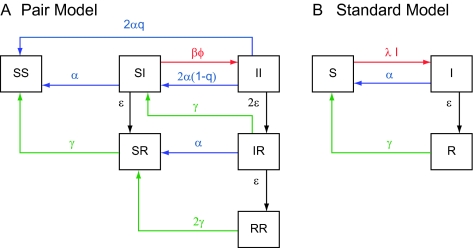Figure 1.
Schematic overview of the chlamydia infection process in a pair model that allows for reinfection in ongoing partnerships (A) and in a standard model in which partnerships are instantaneous and reinfection is not incorporated (B). In the pair model, a compartment consists of a pair of 2 individuals which can be susceptible (S), infected (I), or recovered (R). The pair formation process is independent of the infection process and is therefore not shown in this figure. Transmission can only occur in a pair including a susceptible and an infected individual (SI) with rate βϕ (β denotes the transmission probability per sex act and ϕ the frequency of sex acts, indicated in red). After chlamydial infection, an individual can clear the infection naturally (with rate ε per year, indicated in black). After natural clearance, an individual is immune for a duration of 1/γ years (indicated in green). An individual can also be screened and treated (with rate α per year) and can notify his or her partner with probability q (indicated in blue). The partner always accepts treatment. After treatment no immunity is assumed. In the standard model, the transmission parameter λ is a combination of the number of new partners per year and the transmission probability per partnership.

